|
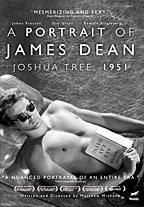
A Portrait of James Dean: Joshua Tree, 1951
Wolfe Video,
2012
Director/Screenplay:
Matthew Mishory
Starring;
Matthew Mishory
James Preston,
Dan Glenn,
Dalilah Rain,
Edward Singletary,
David Pevsner,
Nick Heyman,
Erin Daniels,
Robert Gant
Unrated,
93 minutes |
Forever Young
by
Michael D. Klemm
Posted online May, 2013
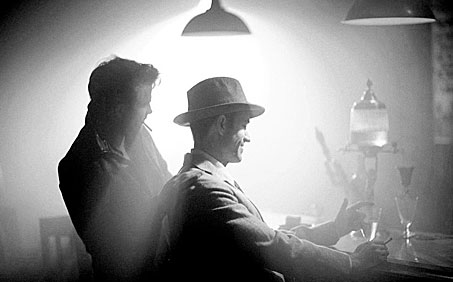
Iconic movie stars are so much a part of our cultural fabric. Whether it is Marilyn Monroe or Marlon Brando, Judy Garland or Humphrey Bogart, almost everyone I know has a pet favorite. I’ll come right out and say it; mine is James Dean. He was more than just a pretty face. He was a screen legend who became the characters he played. He only made three films during the short trajectory of his career – East of Eden, Rebel Without a Cause and Giant – and was unforgettable in each of them. He lived fast and died young, crashing his sports car at the age of 24. |
 A Portrait of James Dean: Joshua Tree, 1951, the debut film from writer/director Matthew Mishory, is a fascinating fantasia on the life of Dean before he achieved mega-stardom. Exquisitely filmed in black & white on 35mm film with period lenses, Dean’s era is evoked in film noir style, augmented by desert photography reminiscent of Ansel Adams, and beefcake pool scenes that could have been shot by Herb Ritts. It also sports an effective and understated performance by James Preston (TV’s The Gates) in the title role. A Portrait of James Dean: Joshua Tree, 1951, the debut film from writer/director Matthew Mishory, is a fascinating fantasia on the life of Dean before he achieved mega-stardom. Exquisitely filmed in black & white on 35mm film with period lenses, Dean’s era is evoked in film noir style, augmented by desert photography reminiscent of Ansel Adams, and beefcake pool scenes that could have been shot by Herb Ritts. It also sports an effective and understated performance by James Preston (TV’s The Gates) in the title role.
|
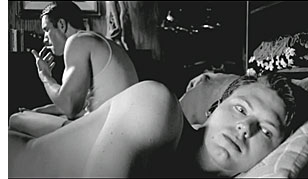 It has long been rumored that James Dean enjoyed affairs with both men and women, and the more recent biographies confirm this. If that’s the main reason why you want to see the film you won’t be disappointed. Dean, we will discover, had affairs with many men. There is a Roger, a producer who throws private pool parties; a roommate; and another young actor who shares Dean’s obsession with bull fighting. I have watched the film twice. Between viewings, I pulled a book off the shelf that I bought years ago but never read: Paul Alexander’s 1994 biography of Dean, Boulevard of Broken Dreams. Imagine my surprise when I opened the book at random and found documentation of the sex scene between Dean and the other young actor. After flipping through the book some more, I realized that many of the director’s presumed flights of fancy are actually factual. It has long been rumored that James Dean enjoyed affairs with both men and women, and the more recent biographies confirm this. If that’s the main reason why you want to see the film you won’t be disappointed. Dean, we will discover, had affairs with many men. There is a Roger, a producer who throws private pool parties; a roommate; and another young actor who shares Dean’s obsession with bull fighting. I have watched the film twice. Between viewings, I pulled a book off the shelf that I bought years ago but never read: Paul Alexander’s 1994 biography of Dean, Boulevard of Broken Dreams. Imagine my surprise when I opened the book at random and found documentation of the sex scene between Dean and the other young actor. After flipping through the book some more, I realized that many of the director’s presumed flights of fancy are actually factual. |
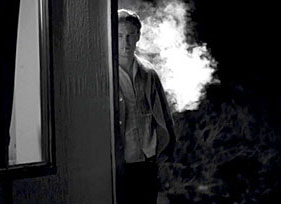 Images of Joshua trees open the film. The sound of howling wind segues into the over-amplified hissing of a burning cigarette shot in close-up. We see the face of a young man, presumably Dean, he is breathing heavily, suggesting rapture. The underground filmmaker Kenneth Anger wrote, in the follow-up to his notorious tinsletown gossip classic Hollywood Babylon, that Dean was known as the “human ashtray.” Back to the film… can you guess what happens next? Images of Joshua trees open the film. The sound of howling wind segues into the over-amplified hissing of a burning cigarette shot in close-up. We see the face of a young man, presumably Dean, he is breathing heavily, suggesting rapture. The underground filmmaker Kenneth Anger wrote, in the follow-up to his notorious tinsletown gossip classic Hollywood Babylon, that Dean was known as the “human ashtray.” Back to the film… can you guess what happens next?
|
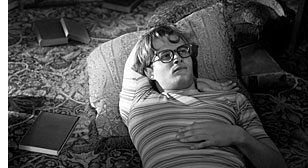 The film might be confusing at first but it becomes so hypnotic that you just go with the non-linear flow. It helps that, unlike many other experimental filmmakers, Mishory was nice enough to provide titles to establish the setting when it suddenly shifts. This is good, because in the first three minutes of the film we go from Arthur Rimbaud’s Bedroom, Charleville, France, 1873 to Rev. DeWeerd’s study, Fairmont, Indiana 1947 (“It’ll be our little secret, Jimmy”) to Roger’s Sunset Plaza Home, The Hollywood Hills, 1951. Later settings will include a trip to Joshua Tree Desert, 1951, and UCLA Campus, A Year Earlier for scenes from Dean’s intense acting class, and Dockworker’s Apartment so that we can watch some explicit sex. The film might be confusing at first but it becomes so hypnotic that you just go with the non-linear flow. It helps that, unlike many other experimental filmmakers, Mishory was nice enough to provide titles to establish the setting when it suddenly shifts. This is good, because in the first three minutes of the film we go from Arthur Rimbaud’s Bedroom, Charleville, France, 1873 to Rev. DeWeerd’s study, Fairmont, Indiana 1947 (“It’ll be our little secret, Jimmy”) to Roger’s Sunset Plaza Home, The Hollywood Hills, 1951. Later settings will include a trip to Joshua Tree Desert, 1951, and UCLA Campus, A Year Earlier for scenes from Dean’s intense acting class, and Dockworker’s Apartment so that we can watch some explicit sex.
|
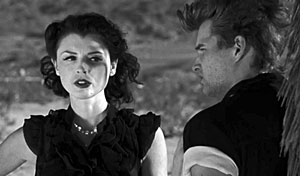 A framing story involves a trip to the Joshua Tree Desert with Dean, his roommate (Dan Glenn) and a “chaperone” – Roger’s assistant, Violet (Dahlia Rain). The unnamed roommate (based on Dean’s real life friend, Bill Bast) is clearly in love with Dean and hurt by his friend’s indifference. Violet, a failed actress, tries to talk sense into the sullen Dean and remind him how the game is played in Hollywood. She seems intrigued by the prospect of rough sex with him. When the roommate thinks about Dean, the film will momentarily flash into color that looks like a grainy 1950s 8mm home movie. A framing story involves a trip to the Joshua Tree Desert with Dean, his roommate (Dan Glenn) and a “chaperone” – Roger’s assistant, Violet (Dahlia Rain). The unnamed roommate (based on Dean’s real life friend, Bill Bast) is clearly in love with Dean and hurt by his friend’s indifference. Violet, a failed actress, tries to talk sense into the sullen Dean and remind him how the game is played in Hollywood. She seems intrigued by the prospect of rough sex with him. When the roommate thinks about Dean, the film will momentarily flash into color that looks like a grainy 1950s 8mm home movie.
|
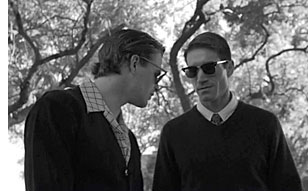 Flashbacks to UCLA feature funny and insightful scenes from Dean's acting class. We also watch Dean and the roommate move in together. While presumably not lovers yet, they act almost like newlyweds. They share "Lightless Fridays," sitting surrounded by candles while they talk about art. Later, when Dean begins to attend Roger's parties and stay out all night, the roommate sits sadly alone amongst the candles to wait for his absent friend. Flashbacks to UCLA feature funny and insightful scenes from Dean's acting class. We also watch Dean and the roommate move in together. While presumably not lovers yet, they act almost like newlyweds. They share "Lightless Fridays," sitting surrounded by candles while they talk about art. Later, when Dean begins to attend Roger's parties and stay out all night, the roommate sits sadly alone amongst the candles to wait for his absent friend.
|
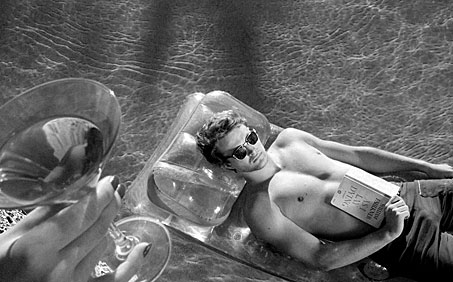 |
We will never know for sure, but the film suggests that Dean was primarily gay. He is portrayed as a sullen young man who likes to experiment, and lives for the moment. The roommate describes his friend as being “crippled inside.” Intense attachments occupy him briefly but he bores easily and, after he gets what he wants, he is ready to move on. He will also do what’s necessary to get ahead and is no stranger to the casting couch. Dean admits this to the other young actor (Nick Heyman) before a lengthy erotic interlude. |
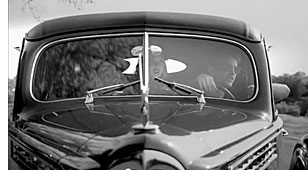 Themes of mortality are interwoven throughout the fragmented narrative. Dean listens, fascinated, while the other young actor tells him about seeing a matador gored in the arena. There is also a grimly funny scene where Dean is pulled over by a cop for driving over 100 miles per hour. Themes of mortality are interwoven throughout the fragmented narrative. Dean listens, fascinated, while the other young actor tells him about seeing a matador gored in the arena. There is also a grimly funny scene where Dean is pulled over by a cop for driving over 100 miles per hour.
|
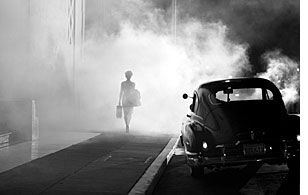 A Portrait of James Dean: Joshua Tree, 1951 is a love letter to Dean, but it’s one with an edge. The images breathe life into the story and I cannot rave about the photography enough. Portrait reminded me a little bit of another admired black and white film from the New Queer Cinema days – Tom Kalin’s 1992 Swoon. It shares many of the same strengths and flaws: like that film, Portrait is also occasionally self-indulgent. I was okay with Rimbaud masturbating while writing an erotic poem about two men but there is a sequence, where a woman recites un-translated French poetry while Dean walks the streets, that was too “artsy” even for me. A Portrait of James Dean: Joshua Tree, 1951 is a love letter to Dean, but it’s one with an edge. The images breathe life into the story and I cannot rave about the photography enough. Portrait reminded me a little bit of another admired black and white film from the New Queer Cinema days – Tom Kalin’s 1992 Swoon. It shares many of the same strengths and flaws: like that film, Portrait is also occasionally self-indulgent. I was okay with Rimbaud masturbating while writing an erotic poem about two men but there is a sequence, where a woman recites un-translated French poetry while Dean walks the streets, that was too “artsy” even for me.
|
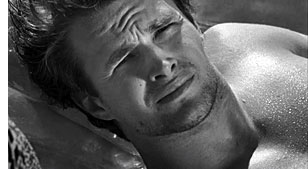 Aside from a few quibbles, I enjoyed this movie. A lot. Preston is believable as Dean. He doesn’t always look like him but he conveys enough presence - with the expected help of wardrobe and hair – to evoke the essence of Dean. Re-creating many iconic photographs helps the illusion. A fine ensemble rounds out the cast. Edward Singletary Jr. is a seductive and slimy Roger. David Pevsner (role/play) is excellent as the acting teacher. Look for cameos by The L Word’s Erin Daniels as the roommate’s alcoholic mother, and Queer as Folk’s Robert Gant as a famous director who wants to get to know Dean better. Aside from a few quibbles, I enjoyed this movie. A lot. Preston is believable as Dean. He doesn’t always look like him but he conveys enough presence - with the expected help of wardrobe and hair – to evoke the essence of Dean. Re-creating many iconic photographs helps the illusion. A fine ensemble rounds out the cast. Edward Singletary Jr. is a seductive and slimy Roger. David Pevsner (role/play) is excellent as the acting teacher. Look for cameos by The L Word’s Erin Daniels as the roommate’s alcoholic mother, and Queer as Folk’s Robert Gant as a famous director who wants to get to know Dean better.
|
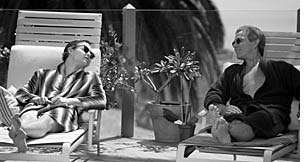 This is not a conventional bio-pic by any means but, for the most part, this is a good thing. Dean remains an enigma, but along the way the viewer is made privy to the man’s deepest secrets so that a nuanced portrait can emerge from the pieces of the puzzle. We will learn much about the acting process, and we will learn a lot about Dean’s convoluted and complicated sexuality. The director mixes fact with flights of fancy, and A Portrait of James Dean: Joshua Tree, 1951 is a pure delight. This is not a conventional bio-pic by any means but, for the most part, this is a good thing. Dean remains an enigma, but along the way the viewer is made privy to the man’s deepest secrets so that a nuanced portrait can emerge from the pieces of the puzzle. We will learn much about the acting process, and we will learn a lot about Dean’s convoluted and complicated sexuality. The director mixes fact with flights of fancy, and A Portrait of James Dean: Joshua Tree, 1951 is a pure delight.
David Pevsner also appears in:
Pornography:
A Thriller
Adam & Steve
The Fluffer
role/play
Old Dogs & New Tricks
Robert Gant also appears in:
Queer as Folk
Save Me
Erin Daniels also appears in:
The L World |


 It has long been rumored that James Dean enjoyed affairs with both men and women, and the more recent biographies confirm this. If that’s the main reason why you want to see the film you won’t be disappointed. Dean, we will discover, had affairs with many men. There is a Roger, a producer who throws private pool parties; a roommate; and another young actor who shares Dean’s obsession with bull fighting. I have watched the film twice. Between viewings, I pulled a book off the shelf that I bought years ago but never read: Paul Alexander’s 1994 biography of Dean, Boulevard of Broken Dreams. Imagine my surprise when I opened the book at random and found documentation of the sex scene between Dean and the other young actor. After flipping through the book some more, I realized that many of the director’s presumed flights of fancy are actually factual.
It has long been rumored that James Dean enjoyed affairs with both men and women, and the more recent biographies confirm this. If that’s the main reason why you want to see the film you won’t be disappointed. Dean, we will discover, had affairs with many men. There is a Roger, a producer who throws private pool parties; a roommate; and another young actor who shares Dean’s obsession with bull fighting. I have watched the film twice. Between viewings, I pulled a book off the shelf that I bought years ago but never read: Paul Alexander’s 1994 biography of Dean, Boulevard of Broken Dreams. Imagine my surprise when I opened the book at random and found documentation of the sex scene between Dean and the other young actor. After flipping through the book some more, I realized that many of the director’s presumed flights of fancy are actually factual. 